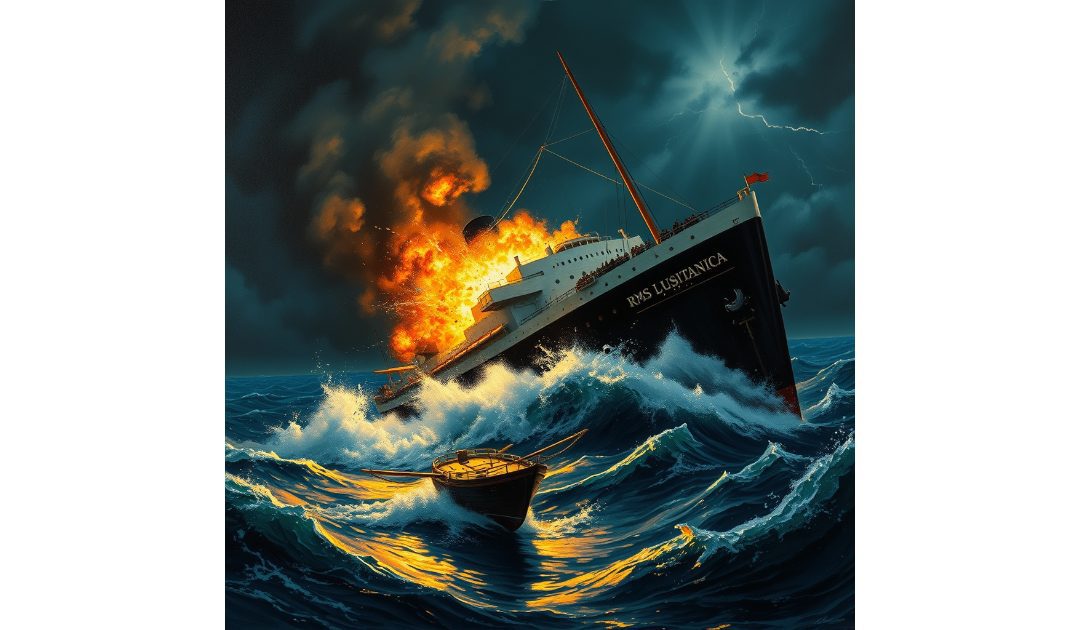On the 7th of May, 1915, the German U20 sank the RMS Lusitania off Kinsale in Ireland. The story of the RMS Lusitania is a tragic chapter in maritime history, forever echoing the perils and politics of early 20th-century travel. Launched on 7th June 1906 by the Cunard Line, the Lusitania was built as a response to increasing competition in the transatlantic passenger market. It was a marvel of its time, representing the pinnacle of Edwardian engineering and luxury.
At the time of her launch, the Lusitania was the largest ship in the world, stretching nearly 790 feet in length. With her majestic four funnels and a top speed of 26 knots, she was designed to be the fastest and most luxurious passenger liner on the North Atlantic route. This speed was not merely for commercial advantage but also had strategic military implications. The British government had subsidized both the Lusitania and her sister ship, the RMS Mauretania, with the understanding that they could be requisitioned for use as armed merchant cruisers in times of war.
Inside, the Lusitania was nothing short of opulent. Her interiors were adorned with the finest woodwork and fixtures, while amenities included a lavish dining room, a smoking room, a library, and elaborate suites. She could carry over 2,000 passengers, offering them unprecedented comfort and style.
The Lusitania’s story took a dramatic turn during the First World War. On 1st May 1915, she set sail from New York on what would become her final voyage. World War I was raging, and German U-boats were a constant threat to ships in the Atlantic. Despite warnings from the German embassy that the waters around the British Isles were a war zone, the Lusitania held to her course.
On the 7th of May, 1915, as she approached the south coast of Ireland, the Lusitania was torpedoed by the German submarine U-20. The ship sank in just 18 minutes, tragically taking with her 1,198 of the 1,959 souls on board, including 128 Americans.
Among the stories of survival came harrowing accounts that painted a vivid picture of the disaster. One survivor, Charles Lauriat Jr., a prominent Boston bookseller, recounted the immediate chaos following the impact. “There was a shock and then a dull explosion,” he described, “the ship took a heavy list to starboard.”
Margaret Cox, another survivor, spoke of the panic and confusion as passengers scrambled for lifeboats. “People were rushing about like mad, and there was the greatest panic imaginable,” she recalled. Her account highlights the tragic lack of preparation and the insufficient lifeboat drills that compounded the disaster.
Young Mary Conner, travelling with her family, provided a poignant recollection of being separated from her parents in the chaos. “I remember the coldness of the water and the screams,” she later relayed. Miraculously, she survived, pulled onto a lifeboat by a heroic crew member.
The sinking of the Lusitania was a pivotal moment in the First World War. It shifted public opinion in the United States against Germany and was a significant factor in the U.S. decision to enter the war two years later. The incident highlighted the brutal realities of unrestricted submarine warfare and the vulnerability of civilian ships in wartime.
The reaction in Britain was one of shock and anger. The event was used as propaganda to galvanise recruitment and stir anti-German sentiment. The British press accused the Germans of barbarism, and the loss of American lives added a diplomatic dimension to the tragedy. The sinking was heavily publicised, with posters urging men to enlist and avenge the Lusitania.
The Lusitania continues to be a subject of fascination and scholarly debate. Conspiracy theories abound, some suggesting that the ship was deliberately sacrificed to draw the United States into the war. Others focus on the mysterious second explosion that hastened her sinking, speculating whether she was carrying munitions.
In 1982, the wreck of the Lusitania was discovered off the coast of County Cork, Ireland. Subsequent dives have aimed to uncover more about the ship’s final moments. The questions regarding her cargo and the reason for her rapid sinking continue to intrigue historians and maritime enthusiasts.

